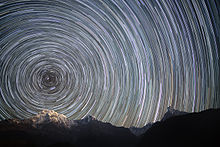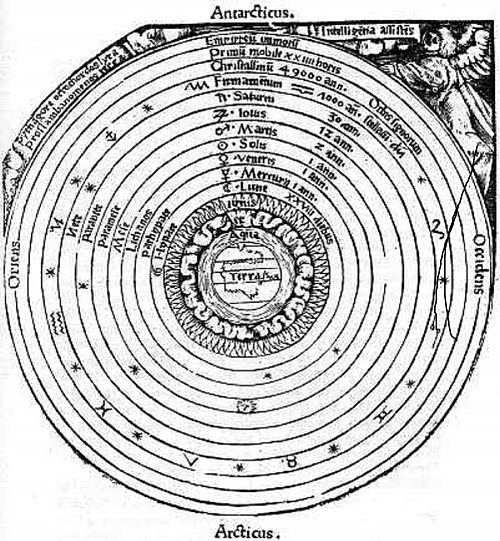Foundations of Science/First Steps – Astronomy
First Steps - Astronomy[edit | edit source]

As arguably the oldest science, astronomy seems a good place to begin our investigation into the nature of the universe. For now, we will begin with a look at planetary astronomy - our solar system - and that look will begin with some simple observations of the sky.
An inexperienced stargazer sees the sun, moon and countless stars, all revolving more or less together about the earth, completing approximately one revolution every day. As for the planets, they are at first entirely unnoticed. Only careful repeated observation reveals that while nearly all the stars have seemingly fixed positions with respect to one another, five of them (restricting ourselves to the five that are visible to the naked eye) are moving about the night sky on there own, entirely independent of the rest. These points of light are called planets, from the Latin planetes meaning wanderer. Although they move independently of the stars, interestingly, they do not wander just anywhere through the night sky, but are restricted pretty much to the same path as that followed by the Sun and Moon. Although the appearance of the planets does not significantly differ from the other stars, two of them, Venus and Jupiter, are so bright as to be quite easily picked out, and Mars has a definite reddish tinge that, with a bit of practice, makes it unmistakable. Mercury and Saturn are not so easily identified without some familiarity with the night sky.
As mentioned above, to all appearances the Sun, Moon, stars and planets all revolve about the Earth in about one day. As we all know, the length of the day is determined by the time taken for the Sun to complete its passage around the Earth. Repeated observation over a period of time reveals that the stars are spinning about the Earth slightly faster than the Sun, and stars that we see rise in the east or set in the west, do so a little earlier every day. For example, if we look up at the sky at midnight around the middle of October, we can see Orion, a winter constellation that is easily recognized, rising in the east. Since it rises a little earlier every day, it is seen continually higher in the eastern sky as fall progresses. By the start of the new year, Orion is pretty much directly overhead at midnight and finally we see it setting in the west around the middle of March. An entire revolution of the stars relative to the Sun marks the length of our sidereal year.
The Moon also moves from west to east against the backdrop of the stars, though this is easily observable from one night to the next. It moves at a rate of about 12° per night so that it completes its revolution in a short 29.5 days. In this way the motion of the Moon has determined the length (and the name) of our month. One of the most dramatic things about the Moon is its continually changing phases, a result of the relative positioning between it, the Sun and ourselves. These phases are readily divisible into four parts marked by the new moon, first quarter, full moon and third quarter. The time taken for the Moon to move from one of these quarters to the next is about 7 days, the length of our week!
On a side note, the number 7 has been a rather mystical number in our history. While it takes 7 days for the Moon to move from 1 phase to the next, the number of known heavenly bodies, other than stars, prior to just a few hundred years ago was 7. In addition, the metals known to the ancient peoples and highly prized by them were also 7 in number: gold, silver, copper, mercury, iron, lead and tin. Reading some kind of mystical importance into this coincidence – something which comes easily to the human mind - the names of the planets, the metals and the days of the week, have all been interrelated. For more on this, see Classical Planet.
Two of the remaining five planets, Mercury and Venus are known as the Sun’s companions because they never stray too far from the Sun. Thus they may be seen in the eastern morning sky before the Sun rises or in the western evening sky just after the Sun has set. Venus is often referred to as the ‘morning star’ or ‘evening star’ because of its prominence in the sky at these times. Because Mercury and Venus always stay close to the Sun, they also take, on average, about a year to move around the Earth. Mars takes almost 2 years, Jupiter almost 12 years and Saturn almost 30 years to complete their respective orbits.
The orbital period of the planets provides a basis for ordering them and constructing a model of our “universe”. Figure 1, which may be referred to as the Aristotelian model, places the Earth at the centre of the universe, encased in a series of concentric shells containing, in order, the Moon, Mercury, Venus, the Sun, Mars, Jupiter, Saturn and finally all the stars. As may be imagined, there was some controversy as to whether Mercury and Venus should be placed below or above the Sun and there was even an ancient Egyptian system which placed Mercury and Venus in orbit about the Sun[1]. Each of these spheres moved independently of the others, but their motions were superimposed on a 24 hour revolution which they all shared due to the outermost sphere, the First or Prime Mover.

The Aristotelian model of the universe drew a sharp distinction between the ‘starry heavens’ and the ‘sub-lunar’ world which we occupy. The quiet uniform motion of the stars and planets seemed to continue unchanging with mathematical precision, yet our world was marked by violent, sometimes catastrophic change, a continual roiling of creation and destruction, life followed by death. In a desire to categorize and understand, the ancient Greeks simplified the complexity by positing that all matter was composed of four fundamental elements: Earth, Water, Air and Fire. These would intermingle and combine to form an astounding variety of materials, whose properties and motions varied with the proportions of the elements which entered into their composition. One can easily imagine how this system could have been conceived. Our world seems to have three fundamental types of matter: the earth upon which we stand, the water forming our rivers and oceans and the air in which we live and breath. Fire, such an important part of our everyday lives, then and now, seems mysterious and quite unlike anything else. Indeed, watching a piece of wood burn, we can observe the escape of Fire, Air and Water while in the end ash remains as Earth. The illustration of the Aristotelian universe (Figure 1) shows these elements, with Earth (Terra) at the centre, surrounded in turn by Water (Aqua), Air (Aer) and Fire (Ignis).
The Ptolemaic Model of the Universe.
- ↑ Page 34 in Small, Robert 1804 “An Account of the Astronomical Discoveries of Kepler” Reprinted by The University of Wisconsin Press, Madison, 1963.